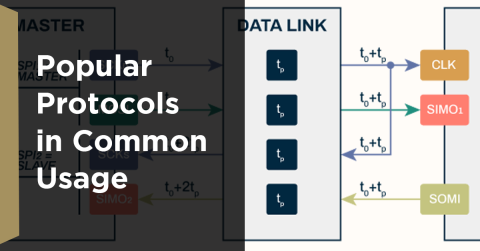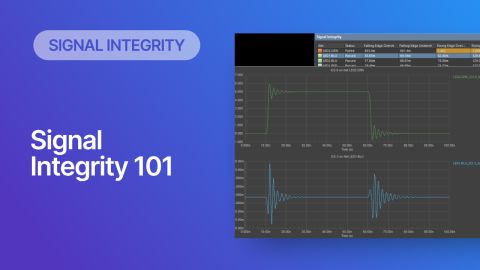Where Does the Knee Frequency Formula Come From?

Continuing with this short series on high-speed signal integrity misconceptions, there is one formula that pops up again and again in elementary signal integrity discussions. This formula is the so-called knee frequency formula, and it is used interchangeably with some -3 dB frequency. What is interesting is that this is so often quoted as a value for the highest frequency contained in signal's bandwidth, which is not correct.
Before even beginning on this discussion, we have to address a very important point:
|
|
The above statement can be proven with a basic Fourier series calculation. The calculation is sometimes given as a homework problem in electronics classes and in intermediate mathematics classes.
The knee frequency is another one of those old guidelines that is cited in situations where it does not apply, and it can be proven to be incorrect in real systems. The basic conceptual understanding behind the knee frequency is also misunderstood by many designers, including by newer designers trying their hand at SI topics.
With that out of the way, let’s dig deep into the meaning of the knee frequency and its conceptual origins.
Why Designers Quote the Knee Frequency
The knee frequency is often quoted in two areas:
- Test and measurement, specifically with measurements of RC circuits or low-pass filters with frequency analyzers or oscilloscopes
- In high-speed PCB design, where it is stated as a highest frequency value contained in a digital signal
The test and measurement folks have it correct and they understand what it is they are measuring: they are measuring a channel’s response to some input signal. The 2nd point is only correct in specific situations and is incorrectly attributed to the signal, rather than the channel. To see why this is the case, we have to go back to a simple channel model and look at the channel termination, then we can derive the channel response in terms of the rise time seen in the channel.
Knee Frequency Derivation
The knee frequency is derived by considering the rise time of a signal that is sourced to an RC circuit. In this simple situation, a perfect square wave is sourced into a channel with an RC circuit as the load, as shown below. The reason this is used is because it does effectively represent a lossless single-ended transmission line with only a load capacitance (no impedance specification); two common instances where this practically matters is with fast GPIOs and SPI buses.

The resistance in this diagram could be a simple resistive impedance or a transmission line; this is actually the basis of deriving transmission line transfer functions with arbitrary load impedances. Read the linked article to learn more about this.
In the above case, we source a perfect square wave, meaning the square wave has a rise time of exactly 0 seconds by definition. The bandwidth of this signal is infinite, which can be proven by looking at its Fourier series. If this were a perfect logic signal being launched into a channel that is terminated with our RC circuit, we should ask: how will the voltage across the capacitor change over time in response?
This is a simple problem to solve in the Laplace domain using transfer functions; the voltage at the receiver end of the channel (across the capacitor) is given by the well-known formula:

where u(t) is the Heaviside step function. Next, we can calculate the 10%-90% rise time of this voltage in terms of the time constant. If you calculate ln(V(90%)/V(10%)), then you will get the following result:

What did we just calculate? It certainly wasn’t the rise time of the signal we sourced into the channel… that was defined to be zero! What we calculated is just the rise time in the voltage seen at the receiver only due to the interaction between the signal and the receiver. We would get the same thing if we modeled the receiver as terminated at the target impedance.
How do we get a bandwidth value from this? For this we simply notice that the -3 dB frequency of the above RC circuit (commonly cited as the circuit’s bandwidth) is 2𝜋 divided by the time constant. Then we have the following result:

Some results quote the knee frequency as having a 0.5 prefactor instead of 0.35. No matter what prefactor is used, we have to interpret this correctly. The correct interpretation is not that a digital signal only contains frequencies up to the above value, it is that this is the minimum amount of bandwidth a digital signal needs to cause the exponential approach response that is normally observed in an RC circuit.
This gives our first conclusion:
|
|
Another way to think about the knee frequency is as follows:
|
|
In a real interconnect, where there is always some distance between the line and load, this is not the case. When the distance between the driver and receiver is longer, there will be greater difference between the injected and received signals.
What is the Channel Response With a Transmission Line?
The above result tells us the minimum bandwidth needed to trigger the exponential approach response. It also only considers a direct connection with resistive impedance to a load capacitance, there was no transmission line considered at all. Real channels could be very different, and you may not find such a simple result that relates the channel’s bandwidth requirement to its response time, or to the signal’s rise time.
To determine the channel response, you need to know:
- The impedance and propagation constant of the channel
- The channel’s transfer function or impulse response function
Just as an example, let’s look at a pulse response seen at a load in a real channel with losses. The example result below was calculated in Simbeor; it shows the effects of loss in a long stripline channel. The input edge rate of the pulse was 4.5 ns. Due to losses in the channel, the pulse has been slowed down to 9.9 ns (ignore the non-causal ripples). Note that we have no load capacitance in this channel; termination is assumed to be perfectly matched. If we had some load capacitance, it is possible we might see further slowing in the edge rate at the load.

Does this mean that the bandwidth of the signal is limited to 35.4 MHz? No; the bandwidth of the injected signal is always infinite. The channel and load simply limit the bandwidth that reaches and is used by the load component; this is exactly why the input signal does not look exactly like the output signal, even in a lossless channel.
Here, we have four important conclusions:
|
|
What Is the Bandwidth of a Digital Signal?
The bandwidth of all digital signals, even when injected into a channel and having a slowed edge rate, is always infinite. There is no maximum frequency. Proving this is a simple problem involving calculation of the coefficients in a Fourier series. To show this, consider a trapezoidal signal with specified rise and fall times as shown in the diagram below.

If you use complex exponentials as the orthonormal basis functions in your Fourier series representation, you can show that the peak amplitudes of the Fourier frequencies follow a sinc function trend; nearly the same result is found with a square wave. This function contains infinite harmonics; there is no upper cutoff frequency as implied by the typical knee frequency interpretation. Follow this link to find a derivation (pages 3-20 to 3-26) of the sinc envelope.

The question to ask is this: how much of that infinite bandwidth actually matters? It depends… the bandwidth that actually matters is the amount of bandwidth the receiver needs to properly interpret a digital signal. The channel needs to support this minimum amount of bandwidth.
Even in a more realistic situation, where the shape of a signal is approximated as having a Gaussian or Lorentzian edge, the bandwidth is still infinite. Here we’ve only looked at perfect square waves or trapezoidal waves, but more advanced computing interfaces and modulated signals will require channel bandwidths that have nothing to do with a signal’s rise time.
For example, every PAM bitstream exhibits this property, and an understanding of this is very important in most computing interfaces spanning back to Ethernet. Consider another example with PAM-4; if you were to use a 25% UI estimation for the rise time of a 224G PAM-4 bitstream and plug this into the knee frequency formula, you’ll find that the minimum channel bandwidth is about 157 GHz. In reality, the channel only needs a minimum bandwidth of 56 GHz (see this article for an explanation).
Learn more about this topic and view a derivation of the knee frequency in this video.
Summary
While it is true that the knee frequency is a universal relation regardless of the load capacitance and impedance, it is only true for a very specific situation. In general, we do not see this situation arise in practice and the knee/3 dB formulas are only approximations. In some cases, such as the PAM bitstreams cited above, these formulas overestimate the bandwidth required in a channel. They also have nothing to do with the bandwidth of a digital signal, which is infinite.
Whenever you’re ready to start designing your high-speed PCBs, make sure you use the design and analysis tools in Altium Designer®. When you’ve finished your design, and you want to release files to your manufacturer, the Altium 365™ platform makes it easy to collaborate and share your projects.
We have only scratched the surface of what’s possible with Altium Designer on Altium 365. Start your free trial of Altium Designer + Altium 365 today.











